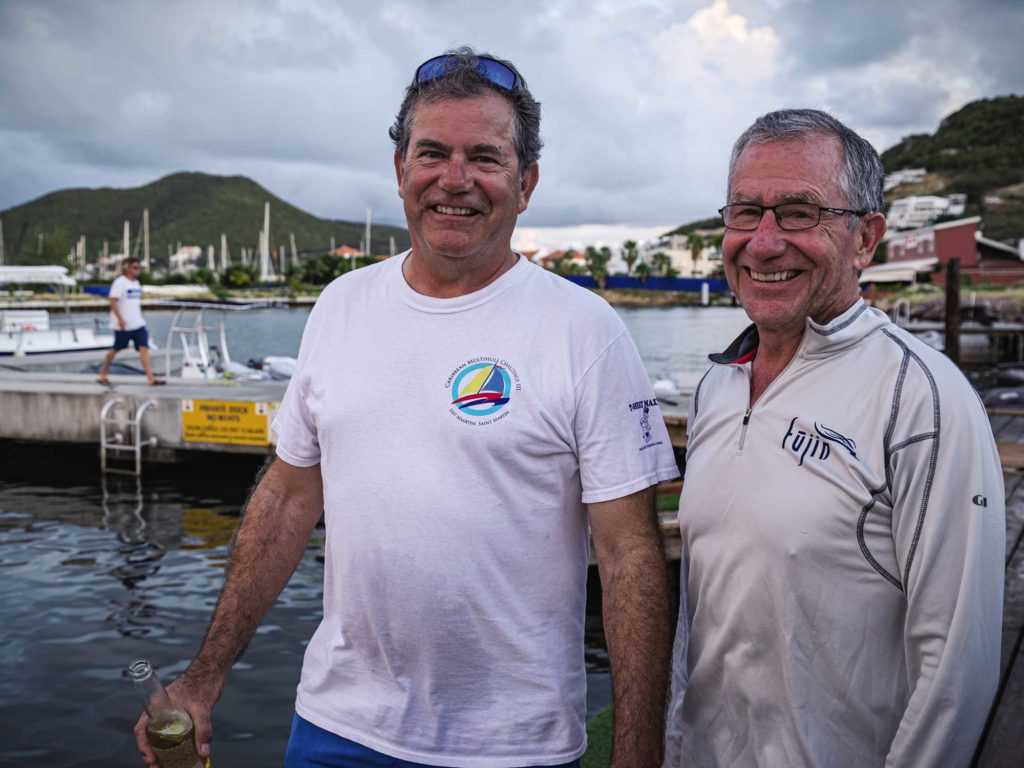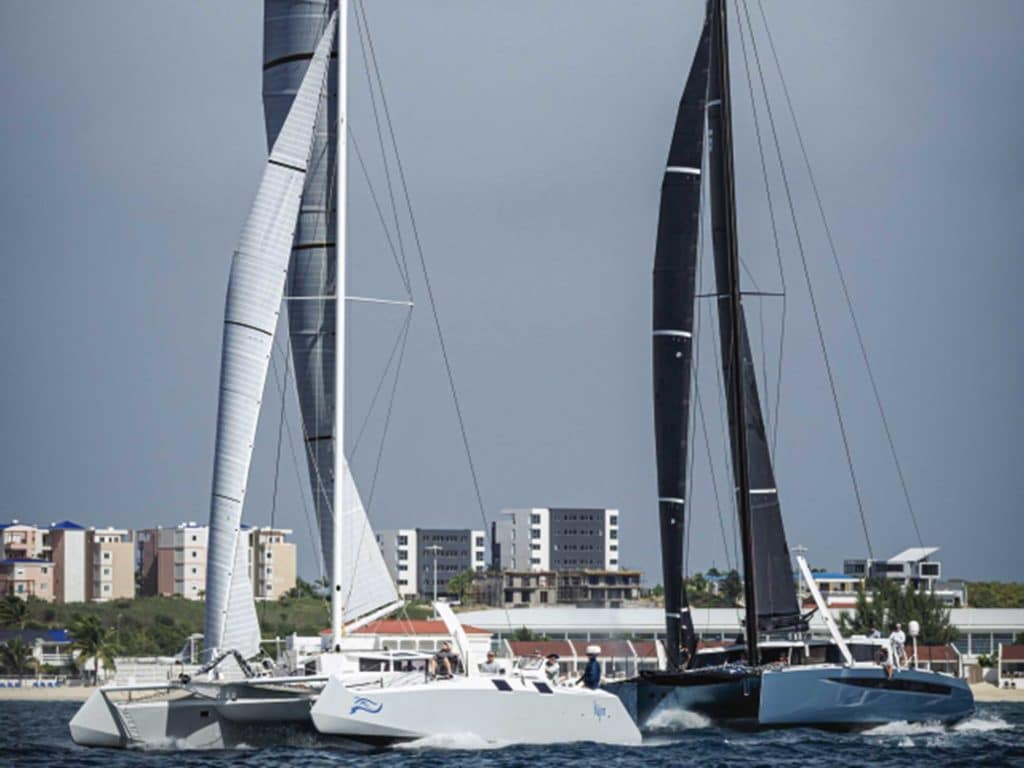
Gino Morrelli has a word for them: outliers. He’s referring to the community of sailors drawn to the ever-expanding fleet of high-end, high-performance, hefty-price-tag, no-holds-barred catamarans that he and his design partner, Pete Melvin, have unleashed upon the sailing world. Their eponymous Southern California naval-architecture shop, Morrelli & Melvin, is responsible for the cutting-edge lines of Gunboat and HH production cats, as well as the late Steve Fossett’s globe-girdling PlayStation and the twin-hulled AC72 winner of the 2013 America’s Cup, Oracle Team USA, among many others. These “dogs,” as they say, know cats—and the dudes who sail them.
“It started with the Gunboats, which were almost like a cult,” Morrelli says. “Exclusive. Expensive. The brand attracted uber-wealthy guys that maybe didn’t want to play the normal IOR-type rule of the day. They were outliers in their professional space, where they’d had great success, and in their sailing too.”
The world has continued spinning in the decade or so since Gunboat’s bankruptcy and demise, and cats have evolved exponentially too: far lighter, way cooler, much faster. But the outliers remain. Which brings us to a pair of them aboard a set of high-strung performance cats, whose competitive rivalry did not emerge in the usual way—on the racecourse—but rather under the very same rooftop: introducing the brothers Slyngstad, Greg and Todd.
The fifth of eight siblings raised in the San Francisco Bay area, Greg amassed some serious loot during his stint at Microsoft and invested a chunk of it in his 53-foot all-carbon, Paul Bieker-designed Fujin, with a striking profile reminiscent of early Polynesian catamarans. Displacing a meager 7 tons (“Half the weight of a Gunboat 55,” Greg tells me), Fujin has been a consistent presence on the Caribbean circuit for several years now, and it is raced hard and well by a Pacific Northwest posse that includes Olympian and fellow SW columnist Jonathan McKee.
Todd’s the youngest member of the clan, who earned his dough in construction in Silicon Valley. He was bitten hard by the cat bug after racing with Greg aboard Fujin, and when he decided to enter the racing fray himself, he commissioned Morrelli to soup up an HH66, which became his Nemo—a basic platform was already under construction, all ready to get tricked out with lighter window glass, custom rudders and daggerboards, carbon furniture veneers and so on—with a quite explicit request in the design brief.
“Beating his brother was a very specific goal of Todd’s,” says Morrelli, who had the advantage of having already competed against Fujin in the islands aboard another HH66, Nala, and then had a good look at the smaller boat’s polars as he got to work. “I think it’s spelled out in the contract!”
It’s fascinating listening to Morrelli speak about the progression of production cats from those early, rather basic Gunboats to a string of M&M 65 custom cats to the HH carbon sculptures now rolling off production lines in China.
“The main, big difference is daggerboards,” he says. “As we started putting in these much deeper boards, my joke in the office is that I blame our evolution on North Sails. As they improved sail cloth and sailmaking, we went from Spectra pinhead mainsails—the old-fashioned, kind of rounded roach things—to fat heads. We have more carbon in the sails now than we used to have in the entire boat. I’m kind of kidding, but that’s really close. The first Gunboats were still fiberglass and Kevlar exterior skins. They weren’t even pure carbon boats when we started because everybody was still a little afraid of building an all‑carbon boat.

“Nobody ever talks about the ‘damage tolerance’ of carbon anymore. As North improved the sailmaking, the reachers got better, the spinnakers got flatter, the sails got stiffer. And as we started increasing the horsepower in the engine
—the 3Di sails—the boats went a little faster, but it wasn’t until we put bigger daggerboards on ’em that they really took off.”
Now the brothers have unholstered their respective arms—Fujin and Nemo—and the time to talk is over. A full season of Caribbean racing will kick it off; at press time, the brothers were scheduled to line up in the fourth running of early February’s St. Maarten Caribbean Multihull Challenge. It will be their second head-to-head battle: In last summer’s moderate-air, 240‑mile Vineyard Race on Long Island Sound and Buzzard’s Bay, Nemo was the handy victor, thanks to the combo of a longer waterline and more sail area. So, the conventional wisdom, at least thus far, goes that Fujin will require a small gale to take on the younger brother’s bigger vessel.
“In light air up to around 15 knots, as they showed, they’re going to kill us,” Greg admits. Which is why he is very much hoping for the staunch trade winds the Caribbean regularly serves. “Yeah, when the wind picks up…” he says, then pauses. “Well, we haven’t had that race yet. But that’s what I’m looking forward to in St. Maarten.”
But Todd is also ready for the duel and reckons Nemo may be a bit more competitive in windy conditions than his brother realizes. “I think we can still take them up to 18, 19, 20 knots,” he says. “We have the longer waterline, and when the sea state kicks up in heavier air, I’m not going to get kicked around like Fujin does; I’m going to accelerate through that stuff. I mean, it’s all speculation on my part, but I think we’ll do well on those 25-plus days. It should be fairly close. I’m anxiously awaiting to see what happens.”
And just what does the (somewhat) neutral observer, Gino Morrelli, reckon?
“I think it’s still TBD in a breeze, especially on a reach,” he says. “They’ll drive the living s— out of Fujin. I’ve seen it. I mean, they drive that boat completely underwater. And Nemo, being a taller rig, higher center of gravity, it’s definitely got the advantage in the medium and the light air. Once you start reefing, I think Fujin, because of its beam and its lower center of gravity, well, it’ll come down to who can keep their foot on the floor the longest.”
While the final outcomes in the regattas to come remain uncertain, on one matter there is no doubt, none whatsoever: One bro is going to teach the other one a lesson.









